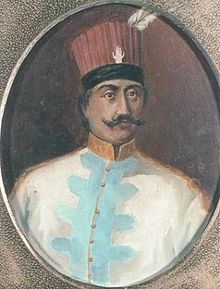Lambros Katsonis
Lambros Katsonis , also Lampros Katsonis ( Greek Λάμπρος Κατσώνης , * 1752 in Livadia , † 1804 in Moscow ) was a Greek freedom fighter and admiral .
Life
Katsonis came from Livadia in central Greece, which was then part of the Ottoman Empire . His family was persecuted by the Turks and fled with him when he was a child to the Ionian Islands , which were not under Ottoman rule. Katsonis later placed himself in the service of the Russian Navy. At the beginning of the 6th Russian Turkish War in 1787 , he commanded a Russian warship in the Black Sea . Through some daring actions against Ottoman ships, he gained military recognition and the field marshal and adviser to the Russian Tsarina Grigori Potjomkin became aware of him.
On behalf of Catherine II , he went to Greece to prepare for a Greek uprising, the Orlov revolt . He met u. a. the freedom fighter Georgios Androutsos , father of the later freedom fighter from 1821 Odysseas Androutsos . Later he went to Trieste , where he equipped three frigates with the help of Greeks living there and stabbed into the Aegean Sea from there . There he attacked Turkish ships and inflicted heavy losses on them. In addition, he captured 12 more ships during this time and thus increased his fleet to 15 ships. The ships of the captains Psaros and Tamaras joined his fleet, and his fleet increased to more than 20 ships. A network of secret supply bases for his fleet was established on the islands. Katsonis attacked Turkish bases on the islands with his ships. B. on the island of Kastellorizo . The main base in the Aegean was the island of Kea . During this time the Ottomans lost control of the Aegean Sea.
Katsoni's fleet also sailed to the eastern Mediterranean, Cyprus, Syria and Egypt and sank numerous ships under the Turkish flag; others were captured and added to the fleet.
In 1788 the Sultan dispatched the Ottoman fleet to the Aegean Sea with orders to find and destroy Katsoni's fleet. At the end of August of the same year, the two fleets met near the island of Karpathos . A heavy battle ensued that lasted several hours. Despite the numerical inferiority of the Katsonis fleet, the Turkish ships suffered heavy losses and were forced to flee. After the victory, Russia recognized Katsonis' fleet as part of the Russian fleet, and Katsonis was made an admiral.
In October 1788, Katsonis returned to his base in Trieste. There he prepared further plans together with Psaros and Tamaras and recruited more Greek volunteers for his fleet, which was getting bigger and bigger.
Meanwhile France charged Katsonis with piracy and demanded his arrest. Due to French pressure, Katsonis was arrested by the Austrian authorities in January 1789, but released again in March 1789 after the intervention of Potjomkin.
After his release, Katsonis went to Ithaca , where he met his friend Georgios Androutsos and planned military actions with him. As an expression of the friendship between the two, Katsonis sponsored Androutso's son Odysseas. After leaving Ithaca, he captured other ships and added them to the fleet. During this time the Sultan sent him a letter in which he described Katsonis as a "manly hero" and offered him amnesty if he placed himself in his service. He promised Katsonis and his men a lot of gold and land. But Katsonis, who was interested in the freedom of Greece, refused. After receiving the answer from Katsonis, the Sultan again dispatched the Ottoman fleet to the Aegean Sea.
At the beginning of June 1789 there was another sea battle in the Cyclades . Once again, Katsoni's fleet emerged victorious. In the spring of 1790 the third naval battle between the two fleets broke out. This time the Katsonis fleet suffered heavy losses and had to withdraw. In 1790, Russia and the Ottoman Empire signed an armistice and Katsonis was notified not to undertake any further attacks. However, Katsonis refused. On May 26, 1790, he attacked Ottoman and French warships in the port of Porto Kagio in the Peloponnese. He was supported from the land side by troops from Androutsos. The fighting lasted three days and resulted in heavy losses on both sides. After that, the ships of Katsonis withdrew. Androutsos crossed the Peloponnese towards Central Greece with the help of local freedom fighters and returned to Ithaca. There he was arrested by the Venetians and handed over to the Turkish authorities, who tortured him to death in Constantinople .
Katsonis went to Russia and lived there until his death in 1804.
literature
- Friedrich Karl Kienitz: Katsonis, Lampros . In: Biographical Lexicon on the History of Southeast Europe . Volume 2. Munich 1976, p. 384 f.
| personal data | |
|---|---|
| SURNAME | Katsonis, Lambros |
| ALTERNATIVE NAMES | Katsonis, Lampros |
| BRIEF DESCRIPTION | Greek freedom fighter and admiral |
| DATE OF BIRTH | 1752 |
| PLACE OF BIRTH | Livadia |
| DATE OF DEATH | 1804 |
| Place of death | Moscow |
